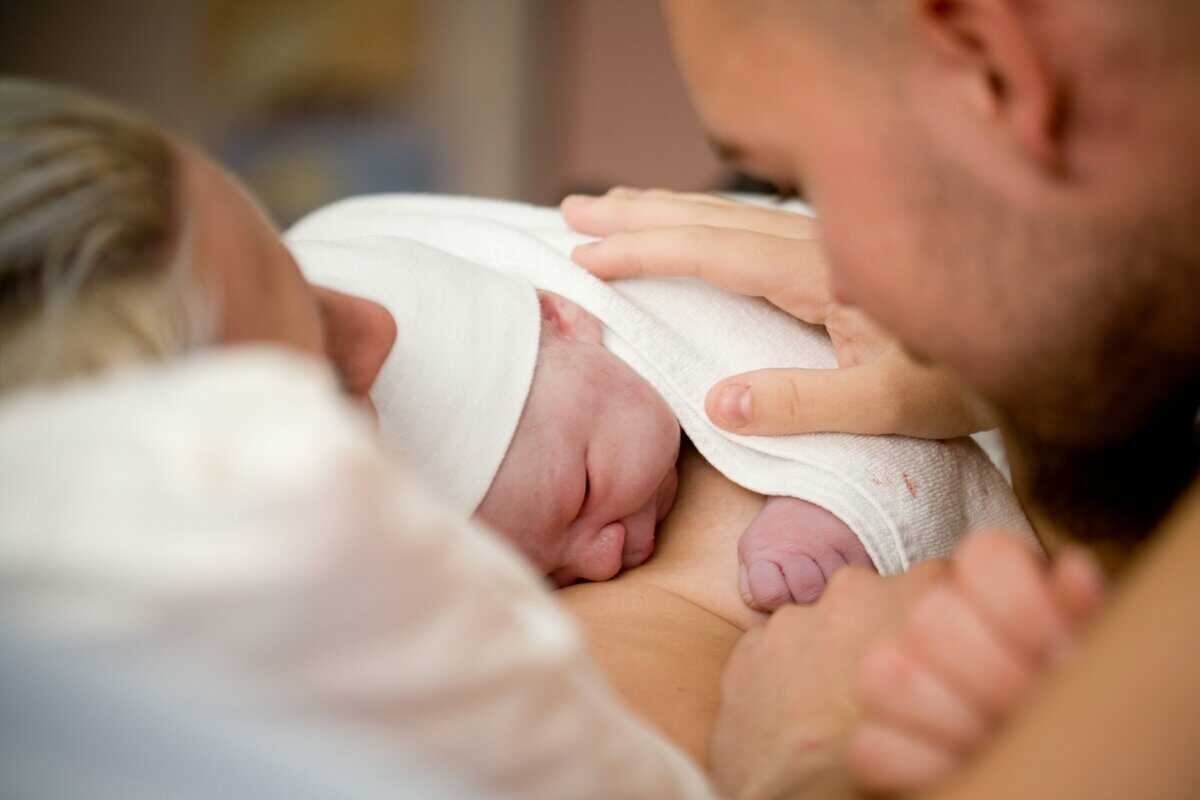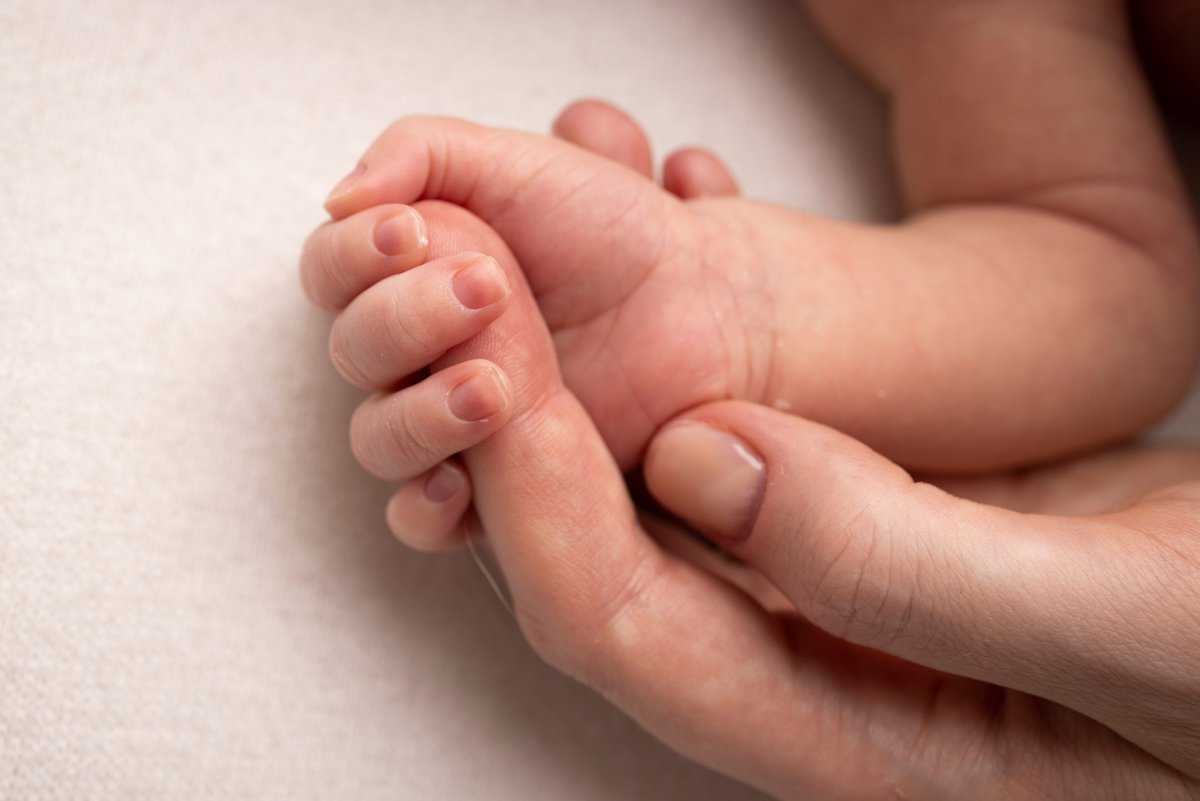The golden hour after birth is a term used to describe the first hour of a newborn’s life.
In particular, it concerns the immediate skin-to-skin contact after a baby is born.
However, it’s so much more than that.
The moment a baby is born, the mother is also born.
– Rumi
The first few seconds, never mind minutes, are magical and life-changing. That’s when the stress subsides, and mothers finally lay their eyes on their beautiful creation.
But what should happen during the golden hour after birth?
Parents often wonder that themselves. In truth, the first hour is very important.
In this article, we aim to shed light on the true meaning of the golden hour after birth, as well as offer insight into all the benefits and to help you prepare for this special moment.
What Is the Golden Hour, Exactly?

After birth, the baby is placed on your chest for skin-to-skin contact.
The benefits of this practice are numerous, both for the baby and the mother.
Even though it’s typically called an hour, the golden hour can last up to two hours. The primary focus lies in helping mothers establish a strong, permanent bond with their baby.
During this time, medical interventions and practices take a back seat, unless necessary.
This interval is crucial for the baby due to the numerous benefits it provides.
The golden hour after birth helps a newborn adapt to their new environment.
By practicing uninterrupted skin-to-skin contact, mothers help their baby regulate their temperature, breathing and heart rate. However, it also helps establish breastfeeding.
Hormones are released during early skin-to-skin, which improves milk production.
As a result, the golden hour after birth helps mothers breastfeed successfully.
The physical and emotional benefits are many, but the golden hour after birth is also an opportunity for the exhausted mother to catch some well-deserved rest after delivery.
Focus on connecting with your child and allow yourself to feel relieved and grateful.
Benefits of the Golden Hour for the Baby

During the golden hour after birth, babies benefit in significant ways.
Understanding the benefits promotes awareness of how crucial this special moment is, and not only for the purpose of bonding – but for your baby’s overall health and well-being.
Let’s examine the positive effects thoroughly:
• Skin-to-skin contact
If all goes well, your child will be wiped dry and placed on your bare chest after birth.
Sometimes, a blanket or towel is used to cover the two of you, to help you stay warmer and comfier as you gaze into your baby’s face and feel their skin against your chest.
The primary physical benefit of skin-to-skin contact is temperature regulation.
By cuddling against the mother’s skin, the baby maintains optimal temperature which they might have lost after delivery, having left the safety and comfort of the womb.
It helps them get used to this new and exciting environment.
When your baby is placed on your bare chest, they find and identify your heartbeat.
This is important because it helps them regulate their vital signs and has a calming effect.
The vital signs regulated include heart rate, respiratory rate and blood pressure.
Besides your heartbeat, your baby is calmed by your breathing, too. Not only calmed, mind you, because your every inhale and exhale further stabilizes your baby’s vital signs.
The skin-to-skin contact that takes place during the golden hour after birth extends beyond physical advantages. The primary purpose lies in helping you connect with your baby.
You have likely bonded with your baby during pregnancy, but seeing their tiny little face, hearing their crying, looking into their eyes – this is the pivotal moment of attachment.
Besides, your baby is finally able to hear you and feel the warmth of your skin.
As such, the long-term advantages are significant for both of you.
Another thing we have to mention is that mother-baby bonding aids in breastfeeding.
During the golden hour after birth, it is advised for mothers to try to breastfeed their babies. In these first few special moments of their life, latching on comes naturally.
Don’t force or direct your child too much. Instead, position them smartly and wait.
The advantage is greater when they do it on their own. Offer support and encouragement, but keep in mind that babies are born with a natural reflex to latch on successfully.
All in all, skin-to-skin contact is crucial after birth. Naturally, all the positive effects occur as a result of skin-to-skin contact, but let’s examine the benefits included more closely.
• Stabilization of vital signs
By helping your baby stabilize their vital signs during the golden hour after birth by practicing skin-to-skin contact, you significantly reduce the risk of complications.
With their ear on your chest, they listen to the rhythm of your heart and, as your chest rises and falls, your baby learns to synchronize their breathing with yours, which calms them.
By practicing skin-to-skin contact during the golden hour after birth, you directly and effectively minimize the risks of conditions such as apnea, bradycardia any hypothermia.
The stabilization of vital signs, therefore, is key.
• Establishes breastfeeding
Babies can breastfeed right from the start.
Doing so, in fact, has positive long-term advantages for the baby.
As a new mother, you’re encouraged to take full advantage of this wonderful and unique opportunity to breastfeed your baby by practicing immediate skin-to-skin contact.
Even though the usefulness of breastfeeding is primarily physical, that first time is a magical and ethereal experience for moms, and a moment that you will cherish forever.
The release of hormones, such as oxytocin, further aids in establishing breastfeeding. By initiating it early and successfully, you make it a lot easier to breastfeed in the long run.
If you face any problems breastfeeding in the future, here’s what you need to know.
• Bonding
The first 60 minutes are crucial for bonding. They’re essential.
After labor and delivery, mom and baby finally get to enjoy meeting each other for the first time. The purpose of this time interval is to help both of you bond emotionally.
It’s equally important for both of you.
The benefits are long-lasting for your baby. Starting off on the right foot is important, because it nourishes a sense of love and connection that the two of you can build upon.
The release of oxytocin further enhances attachment.
Since everything is new and maybe even a little bit scary to your baby, holding them close promotes feelings of safety and comfort as you look to calm and connect with your baby.
• Other benefits
The golden hour after birth is essential for a newborn. The positive effects are many.
Let’s do a quick review and include the ones that we haven’t covered in detail.
- Immediate skin-to-skin.
- Stabilization of vital signs.
- Establishes breastfeeding.
- Bonding.
- Improves cognitive development.
- Reduces stress.
- Increases alertness.
- Delayed umbilical cord clamping.
- Many more.
Benefits of the Golden Hour for the Mother

The golden hour after birth is important for moms, too.
After giving birth to a newborn baby, you need some time to regain strength. These 60 minutes provide an opportunity to rest as you form a strong connection with your baby.
Let’s examine how the golden hour after birth affects and uplifts mothers:
• Maternal bonding
The closeness you experience after delivery is magical.
Hormones such as oxytocin and endorphins are released, promoting bonding.
This emotional connection is an important milestone and a step in the right direction.
It provides an opportunity for the mother to take a moment to breathe and to connect with her baby. It’s a crucial step towards ensuring her baby’s healthy development.
Oxytocin, which is often referred to as the ‘love hormone’, is released and it has a positive effect on the child, as well as the mother, promoting feelings of joy, love and affection.
On the other hand, endorphins, which we recognize as natural painkillers, help alleviate any discomfort you may be experiencing due to the stress and exhaustion of giving birth.
Although tired and spent, the feelings of joy and satisfaction will overwhelm you.
Knowing the significance of the golden hour after birth, your body releases these hormones to help you bond and connect with your baby immediately after birth.
• Milk production
Try breastfeeding your baby during this one-hour interval.
After delivery, your body is actively stimulating milk production. Position your baby so that they are close to your breast. Provide help, but let your baby latch on independently.
There’s another hormone at play here – and it’s called prolactin.
This hormone is responsible for milk production. As your newborn latches on and begins suckling, the nerve endings in your nipple and areola activate, releasing more prolactin.
Having relaxed and calm your baby – and yourself – breastfeeding becomes a lot easier. Besides, starting early is ideal for establishing a good milk supply and making it a habit.
For every mom, the first time you breastfeed is another special milestone.
It sets a strong foundation for breastfeeding in the future and stimulates maternal bonding.
If you’re looking for a breastfeeding and pumping schedule – we got you covered.
• Reduces stress
Giving birth is not only painful, but extremely stressful.
It doesn’t matter if it’s your first, second or even third time.
However, during the golden hour after birth, your stress levels are immediately lower.
This special moment washes away the stress and allows you to appreciate and cherish it fully. If there are no complications, you can relax, recover and regain strength.
Soon after birth, mom and baby get to enjoy some quiet time.
It’s important for the delivery room to remain peaceful and quiet during the golden hour after birth because mom and baby need to bond in a safe and stress-free environment.
Take a break and cherish the moment. Look at your baby and allow yourself a smile.
The delivery process is painful and sometimes chaotic, but as soon as you embrace your baby, you will forget what you went through and lose yourself in admiration and gratitude.
• Nourishes confidence
Pregnancy and delivery are two very different things.
You may have formed feelings prior to delivery, but now your baby’s in your arms.
So many challenges lie in waiting, but as you hold your baby tight, the closeness restores your confidence and uplifts you. Remind yourself of how strong and beautiful you are.
Let it come to you naturally because you already have what it takes to be a good mom.
Use this bonding moment to observe, study and admire your child.
Not only their face and body, but also the little movements and cues, the sound of your baby crying. Do this to build a sense of confidence in your ability to care for your child.
Focus on deepening the bond and you will feel invigorated.
• Develops mother-infant communication
From this moment on, you will spend the rest of your lives trying to understand each other to the best of your abilities. Making a good start, therefore, is highly important.
Even though a newborn baby can’t understand words per se, they can recognize your voice. Finally, being able to hear their mother’s voice helps calm and soothe babies.
Besides, there are other ways to communicate, as well.
Communication by touch is key during the golden hour after birth.
It helps newborns feel safe and secure because it signals care and provides warmth.
Make a mental note to respond to your baby’s cues and behavior. This further enhances your communication and helps establish an interactive relationship based on responsivity.
Healthy communication during the first 60 minutes matters more than you think.
It has positive and long-lasting effects on your baby’s life.
• Improves maternal outcomes
After the physical and emotional demands of labor and delivery, you finally get to relax.
An opportunity to rest by embracing your baby has significant positive effects.
Immediately after giving birth, your stress levels decrease. Yes, your body may feel spent for a good while yet, but emotionally you get to experience a truly unforgettable moment.
The golden hour promotes physical and emotional recovery. However, in some instances medical intervention may be needed to resolve any postpartum complications.
Nevertheless, it’s important to note that this time period has been proven to decrease mortality as well as prevent certain postpartum complications, such as hypothermia.
• Other benefits
Mom and baby both benefit during the golden hour.
Let’s take a moment to list the positive effects, as well as include additional ones:
- Promotes maternal bonding.
- Improves milk production.
- Reduces stress.
- Nourishes confidence.
- Develops communication.
- Improves maternal outcomes.
- Facilitates early breastfeeding
- Encourages rest and recovery.
- Many more.
9 Instinctive Stages of the Golden Hour

After birth, a new baby goes through 9 instinctive stages of behavior.
Understanding these behaviors is helpful to parents as they navigate new territory after delivery. By observing your baby’s instinctive patterns, you learn to assess their needs.
This is you meeting your child for the first time.
Naturally, the accuracy of these stages may differ on a case-to-case basis.
Still, here’s what you can expect:
Stage 1 • The Birth Cry
As soon as the newborn takes its first breath, the so-called ‘birth cry’ occurs.
To be exact, the little one is communicating because crying implies communication.
For your baby, everything is new and scary. The world is bright and unknown. However, that first breath indicates that your world is also changing. Your baby is finally here.
A first birth cry is an essential event for both the baby and the parents.
By placing the newborn in the mother’s embrace, the crying soon ends.
After all, it’s on their mother’s bare skin that a baby finds safety and comfort, making the transition from a womb to the outside world a smooth, pleasant and stress-free experience.
Stage 2 • Relaxation
During this stage, a baby relaxes and recovers – much like the mother.
The crying and the alertness decrease as the newborn relaxes in the mother’s embrace.
As adrenaline and stress levels plummet significantly, both the newborn and the mother take the time to drink in the moment, to recover from physical and emotional exertion.
Therefore, it’s important that the delivery room stays calm and peaceful. If all is well with you and your precious little angel, time is given to help you create a meaningful bond.
This is the very start of a connection that will last a lifetime.
Stage 3 • Awakening
Soon after the relaxation stage, a newborn will become more active.
Active, however, implies small and physically restricted movements. You may observe your baby make noises, move their fingers and arms, and often shift their head and shoulders.
With newfound alertness and responsiveness, you get a first glimpse into your little one’s personality. This is an ideal stage for the parents to interact meaningfully with the baby.
During this stage, focus on helping your baby feel secure and loved in your embrace.
Stage 4 • Activity
More movements than before. A desire to explore the environment can be observed.
They become more energetic. This is when the rooting instinct can activate, as well, a positive sign that your baby is hungry. You may remark on the hand-to-mouth signal.
Continue providing a sense of comfort and security.
Interact with your baby. Reward their curiosity and provide verbal encouragement.
It’s during this stage that your bundle of joy may prepare to latch on.
Remain observant of your baby’s subtle and not-so-subtle cues.
Stage 5 • Rest
After some activity, they go quiet and calm again, needing to rest and recover.
Be patient with your little one and make sure that they’re always comfortable.
This stage is an ideal opportunity for parents to admire their baby and further develop their bond. Give yourself time to regain strength as you marvel at your beautiful little angel.
Keep building trust and attachment. Respond in accordance with your baby’s needs.
Stage 6 • Breast crawl
This one’s an eventful stage. Why? Because your newborn is likely to do a breast crawl.
Their natural instincts kick in, especially the stepping reflex, and your newborn starts crawling toward your breast, which provides an ideal opportunity to start breastfeeding.
If this behavior takes place, it’s important that your little one manages to do it on their own. That implies support, but primarily making sure that they manage it themselves.
Your baby is going to attempt to align with the nipple. How you position them is key.
If the newborn manages to feed successfully, it makes for another beautiful moment.
Not just a beautiful moment, but a developmentally crucial one, as well.
Just make sure that you take care of your baby’s position so that they can naturally reach the nipple, which is going to solidify your bond and help you in the long run.
Stage 7 • Familiarization
In the next period, the newborn is busy familiarizing themselves with the breast and the nipple. Expect your little one to touch, rub and lick your breast as they learn the area.
This is a crucial development for a strong and healthy breastfeeding relationship.
The release of oxytocin contributes to milk production. As such, you’re encouraged to make your baby comfortable and give them all the time they need to explore the breast.
Maintain the correct position and your little one will do the rest.
Stage 8 • Suckling
The suckling stage begins when the baby latches themselves on the breast and begins to nurse, which is an important milestone and a special moment for the mom and the baby.
Usually, this happens towards the end of the 60 minutes.
It can last for several minutes or longer.
The positive effects of succeeding in breastfeeding are many, including helping the baby build a strong immune system and getting them used and familiarized with feedings.
Support your little one and adjust as necessary.
A nursing pillow can be used to provide extra support, if needed.
Stage 9 • Sleep
The final stage is usually when the baby and sometimes the mother falls asleep.
After the exertion of labor and delivery, you both need some rest.
The final stage involves your baby drifting off to a peaceful sleep. It means that they trust you, and that they feel warm, safe and comfortable in your embrace as it lulls them to sleep.
This is also a great opportunity to reduce stress and let it all sink in.
Watching your little angel fall asleep for the first time is a beautiful experience.
In fact, it’s a once-in-a-lifetime experience.
Let that thought motivate and inspire you to savor the moment.
In Conclusion

In the end, this special period typically lasts for one to two hours, and it has numerous, as covered thoroughly in this article, positive effects for mothers and their newborns.
As it stands, the primary focus lies in developing a two-way emotional connection.
However, the positive aspects behind this crucial period cover various other things, such as stabilization of vital signs, successful breastfeeding and significant stress reduction.
Having outlined the 9 instinctive stages of a newborn’s behavior, you know what to expect. From the first cry to their first sleep – this is a start of a beautiful journey.
Today, the so-called golden hour is a must after delivery.
Knowing this, you can outline the importance of this period in your birth plan.
Coordinate with the medical staff as well as your friends and family so that your wishes and preferences remain clear throughout – because giving birth is going to exhaust you.
Regardless, giving birth to a child is one of the most beautiful journeys a woman can take.
However, it is a physical and emotional journey – so best be prepared for it.
Do your research beforehand and remind yourself of how strong you really are.

Mother of three and a primary school teacher. I’ve always loved being around children and helping them, so I chose my path as a teacher. It is sometimes hectic with three children, but I am 100 percent into it and wouldn’t change it for anything in the world.



Weird Things That Happen Before Labor • Mama Bean Parenting
Monday 13th of March 2023
[…] learn more about the golden hour. You need that knowledge for yourself and your […]